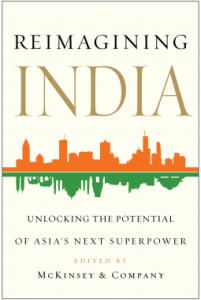Reimagining India: Unlocking the Potential of Asia’s Next Superpower is a volume of some seventy odd essays from prolific individuals and some great minds from India and across the world. McKinsey & Company covers India from all angles in this assortment of essays. Various authors look at India from its pre-independence era to its transformation into a service economy. Authors like Fareed Zakaria and Gurucharan Das look at the social and political progression and make some keen observations about the factors leading to the current state and the promise of future. At the same time, essays by Anand Mahindra and Mukesh Ambani discuss India’s economic progress and the gaps that India still needs to fill to rise to its potential.  Title: Reimagining India: Unlocking the Potential of Asia’s Next Superpower Edited by: McKinsey & Company Publisher: Simon & Schuster; First Edition edition (November 19, 2013) ISBN-10: 1476735301
Title: Reimagining India: Unlocking the Potential of Asia’s Next Superpower Edited by: McKinsey & Company Publisher: Simon & Schuster; First Edition edition (November 19, 2013) ISBN-10: 1476735301 ![]()
Book Review
Reimagining India is not a point-by-point prescription for how to change India, but a discussion by social scientists, scholars, and businesspersons explaining the various complexities of the political situation and the country’s social structure. You will get to read both the good and the bad about India and need to keep an open mind. You should read the book because it does not have any singular agenda and does not exalt India to something it is not. Nor does it paint a completely grim picture by highlighting only the failures of the young republic. In The Rediscovery of India, Fareed Zakaria revisits the post independence challenges that India faced. He argues that India’s diversity posed a serious challenge to initial Nehru led centralized rule model. Notwithstanding this forced political system, regional parties gained importance post Indira Gandhi’s assassination. The author highlights all the longstanding problems where the state has failed, but is optimistic that the much needed interaction with the world and open economy will unite the ever expanding middle class to bury all the divisive instruments and they will demand better governance by the state, as evident from the recent uprisings in New Delhi. In Toward a Uniquely Indian Growth Market, Anand Mahindra looks at how India’s diversity and state autonomy interferes with equal growth, but he claims that the idea on one India is no longer debatable. He points out that India’s geographical diversity along with state autonomy makes some states more attractive to investment than others. This autonomy makes it many destinations and not just one destination for investment for investors. He sees this choice as an advantage and believes states should be allowed further autonomy to pursue their own economic policies. The industrialist also shares his vision of distributed growth and self-sustaining urban centers in contrast to current mega cities like Mumbai and Bangalore. Any Indian citizen who says India is shining or a developed nation is blind to India’s reality. But Bill Gates believes India can achieve it. As MacKenzie McHale would say
“It is not, but it can be” ~ The Newsroom

In What I learned in the War on Polio, Bill Gates drives home this point by illustrating how a concerted effort of all involved parties ensured that India became Polio free. It is a simple story that points out India’s social and logistical problems, but also highlights that its large pool of human resource can be mobilized to reach great heights, if led in the right way. Any discussion these days about India seems incomplete without a comparison with China. Politicians and some others claim that China has and advantage because of its totalitarian regime. This seems to be an easy way out. Yasheng Huang offers various arguments to show that this belief is false and cites India’s sluggish economic development when the Congress party held all the strings under Indira Gandhi as an example of how complete power does not necessarily equal faster economic growth. Just as the comparison with China, India’s demographic dividend is often cited as its most important advantage. In Demographic Dividend – or Disaster? Victor Mallet paints a grim picture. But I couldn’t agree more with what he has to say. “Young India” and younger on the way is celebrated as the savior of India’s progress. At the heart of this theory is that more people to buy means economic expansion. However, if current low growth, high inflation situation is any indication, a billion strong young workforce can easily become a curse, if India fails to generate enough jobs. The author very clearly points out that if India fails to provide jobs, bring advances in agriculture to increase food supply, and educate the exploding population, we may very well be on track to anarchy than development. In summary, the collection of essays realistically paints the challenges India faces ahead and points out that it will need all its resilience and innovation if it wishes to catapult itself into the superpower league. ![]()